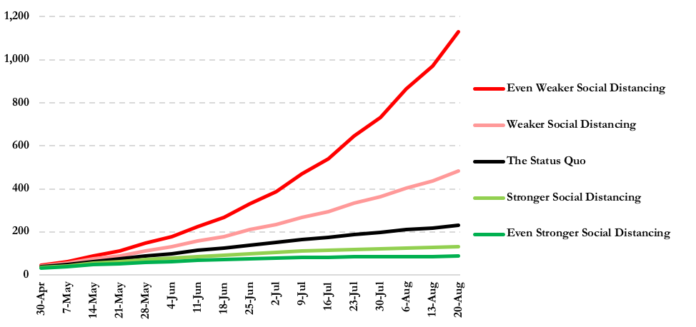University of Louisville
2323 S. Brook St.
Louisville, KY 40208
Community Engagement
Addressing the needs and interests of our communities locally, statewide, nationally and internationally.

A new modeling study by the University of Louisville School of Public Health and Information Sciences and the Louisville Metro Department of Public Health & Wellness (LMPHW) indicates that stringent social distancing measures the city put in place in March have significantly slowed the spread of COVID-19 in the city.
The study, Projecting the COVID-19 Weekly Deaths, Infections, and Hospitalizations for Jefferson County, Kentucky, also projects the city may be able to gradually reopen by early June if even stronger containment measures – especially more extensive testing and consistent contact tracing and quarantine of all newly infected individuals – are implemented.
But the study also warns that if strong and effective social distancing measures are pulled back too quickly, as many as 900 more people in Louisville would die and about 2,000 more would be hospitalized by August.
Seyed Karimi, PhD, an assistant professor in the Department of Health Management and System Sciences at the UofL School of Public Health and Information Sciences, co-authored the report.
“We know from our modeling that decreasing the current social distancing measures without increased efforts to test, isolate, and do contact tracing can move us to an unstable path with increased hospitalization and infection trends that could be catastrophic,” said Karimi, who also is a health economist with LMPHW.
Study co-author Sarah Moyer, MD, director of LMPHW and the city’s chief health strategist, said the study projects that measures the city put in place in March averted a surge of COVID-19 patients that otherwise would have overwhelmed Louisville’s health care system. Going forward, only about 400 of Louisville’s 3,600 hospital beds will be needed for COVID-19 patients if current social distancing measures remain in place.
“This model validates the measures we have put in place to control the spread of COVID-19 in Louisville thus far,” Moyer said. “The study also serves as affirmation of our state and local efforts to slowly release restrictions.”
“The study is a good example of how academic research can inform real-life public health policy decisions to protect community health,” said Craig Blakely, PhD, MPH, dean of the University of Louisville School of Public Health and Information Sciences.
Mayor Greg Fischer expressed his appreciation for the collaborative effort between UofL and the local health department, adding that the data underscores what city and health officials have been saying: “While we’re making progress in the fight against COVID-19, we still have a long way to go.
“Even as some restrictions are eased, we must stay focused and vigilant,” he said. “That’s why I have extended the executive order continuing the state of emergency here until June 1. It’s important that we not get our guard down against this dastardly disease.”
Researchers used the Susceptible-Exposed-Infectious-Recovered (SEIR) model, which measures the effect of public health policy interventions to contain an infection. They projected trends in the numbers of actively circulating COVID-19 infections, active hospitalizations, and deaths in the city from April 20 to August 20.
The authors considered two potential scenarios that estimated the current number of COVID-19 deaths in Louisville. The scenarios consider two different dates for the effectiveness of public and private social distancing policies in Jefferson County – March 31 and April 7, which they labeled as status quo scenarios.
Under each of the two scenarios, researchers considered four potential alternatives reflecting outcomes if social distancing and other containment strategies had been either weaker or stronger by 10% increments. They projected number of infections, hospitalizations, and deaths that Louisville would see under each of those social distancing scenarios.
Their projections show that if stronger containment methods had been used from the presumed intervention days of March 31 and April 7, transmission of the virus would have decreased significantly, such that the number of infections in June would have been in two digits. On the other hand, if weaker containment methods were used from the presumed intervention days, virus transmission would have increased remarkably, such that the number of infections and hospitalization would not soon have stabilized.
Other report authors include Natalie DuPre, ScD, MS, Bert Little, PhD, MA, W. Paul McKinney, MD, all of the SPHIS.
Cardinals make a difference through Alternative Service Breaks
UofL Brandeis School of Law launches immigration law clinic
UofL Green Heart Project: residents’ inflammation lower after trees added to neighborhoods
UofL program empowers local teachers to bring science to life
UofL dental faculty’s experience fuels passion to help those with special needs
UofL College of Education & Human Development to create state reading research center

